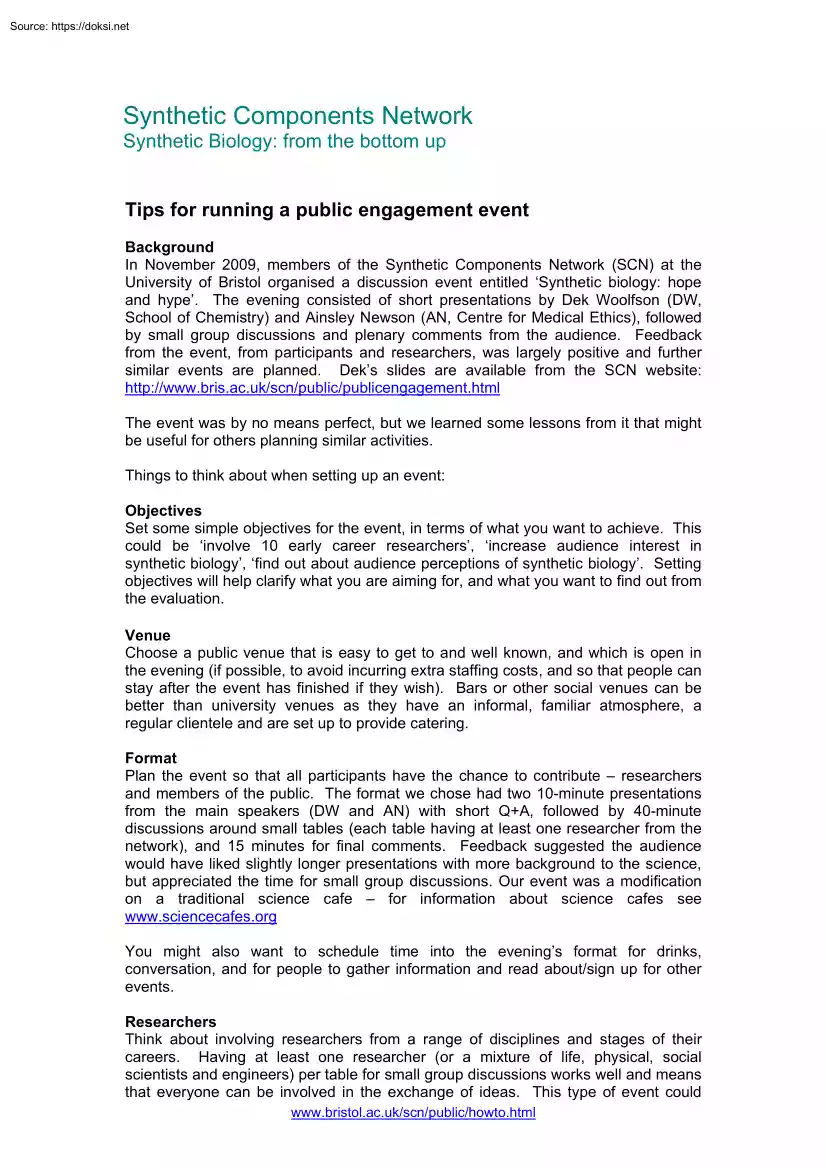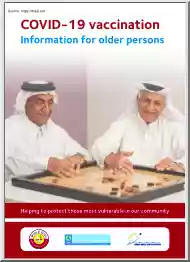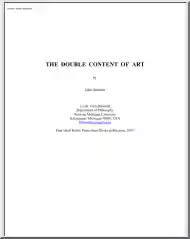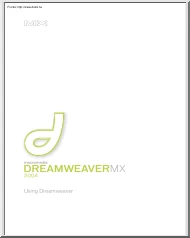Please log in to read this in our online viewer!

Please log in to read this in our online viewer!
No comments yet. You can be the first!
What did others read after this?
Content extract
Synthetic Components Network Synthetic Biology: from the bottom up Tips for running a public engagement event Background In November 2009, members of the Synthetic Components Network (SCN) at the University of Bristol organised a discussion event entitled ‘Synthetic biology: hope and hype’. The evening consisted of short presentations by Dek Woolfson (DW, School of Chemistry) and Ainsley Newson (AN, Centre for Medical Ethics), followed by small group discussions and plenary comments from the audience. Feedback from the event, from participants and researchers, was largely positive and further similar events are planned. Dek’s slides are available from the SCN website: http://www.brisacuk/scn/public/publicengagementhtml The event was by no means perfect, but we learned some lessons from it that might be useful for others planning similar activities. Things to think about when setting up an event: Objectives Set some simple objectives for the event, in terms of what you want to
achieve. This could be ‘involve 10 early career researchers’, ‘increase audience interest in synthetic biology’, ‘find out about audience perceptions of synthetic biology’. Setting objectives will help clarify what you are aiming for, and what you want to find out from the evaluation. Venue Choose a public venue that is easy to get to and well known, and which is open in the evening (if possible, to avoid incurring extra staffing costs, and so that people can stay after the event has finished if they wish). Bars or other social venues can be better than university venues as they have an informal, familiar atmosphere, a regular clientele and are set up to provide catering. Format Plan the event so that all participants have the chance to contribute – researchers and members of the public. The format we chose had two 10-minute presentations from the main speakers (DW and AN) with short Q+A, followed by 40-minute discussions around small tables (each table having at least
one researcher from the network), and 15 minutes for final comments. Feedback suggested the audience would have liked slightly longer presentations with more background to the science, but appreciated the time for small group discussions. Our event was a modification on a traditional science cafe – for information about science cafes see www.sciencecafesorg You might also want to schedule time into the evening’s format for drinks, conversation, and for people to gather information and read about/sign up for other events. Researchers Think about involving researchers from a range of disciplines and stages of their careers. Having at least one researcher (or a mixture of life, physical, social scientists and engineers) per table for small group discussions works well and means that everyone can be involved in the exchange of ideas. This type of event could www.bristolacuk/scn/public/howtohtml also form part of training in engagement and communication skills, which might mean
access to ‘transferable skills’ funding. You might want to gather researchers taking part together, or at least send out a group email, so that they can exchange ideas and expertise (we had a pizza together before the event). Those new to public engagement might benefit from talking to someone who has done it before. There are resources for people new to engagement on the National Coordinating Centre for Public Engagement website, www.publicengagementacuk/our-projects/science-engagement Audience You might have quite clear ideas about the type of audience you want to attract to your event – age, education level/science background, special interest (e.g environmentalists) or you might just be thinking of the ‘general public’. The language of synthetic biology (even the term itself) is likely to be unfamiliar to many people, so ensure that the way you describe the event is accessible to the people you want to attract. Recruit your audience as broadly as possible, using networks
and links outside the university where possible. Take bookings if you can so that you know how many people are likely to attend (this can just be a phone number and Excel spreadsheet of names that you tick off when people arrive). Promotion We developed a simple print and email flyer that was sent to a range of organisations and venues including schools, doctors surgeries and hospitals, libraries, museums/science centres and research funders (available via the link below) http://www.bristolacuk/scn/events/hopeandhypepdf Additionally, a small advert was placed in Bristol’s events magazine. The event was also highlighted on the Centre for Public Engagement’s blog, in our ‘What’s On’ guide to public events at the University and through our Twitter channel. If you are working with partner organisations (e.g a science centre) make sure they also publicise the event to their mailing lists. Evaluation Evaluation can help you develop your events. As well as data about the number of
participants and where they have come from, information about what people liked best and what could be improved will help you shape subsequent events. You could use a Likert (1-5) scale to find out how much people agree/disagree with statements such as ‘I learned something new at this event’, or free response to questions such as ‘what worked well at this event?’ or ‘what would have improved it?’ Results of the evaluation could be circulated to researcher participants after the event and should be used to plan future events. Our evaluation form is attached or for more in-depth information about evaluating public engagement activities see http://www.rcukacuk/aboutrcuk/publications/corporate/evaluationguidehtm Results from our event evaluation can be found on the SCN web site: http://www.brisacuk/scn/outputs/ Cost An event of this type does not require a large budget; £500 should be sufficient (although this depends on venue, and whether you are going to provide food and
drink etc). Major budget items include venue and equipment hire (including tables, chairs, PA system, video projector, bar etc.), food and drink (eg wine and nibbles or tea and coffee), staffing (if necessary), and publicity. The SCN will make funds available to cover these costs, and are also happy to cover the costs of your group of researchers having a (cheap) meal or drink together before the event to share ideas and expertise. www.bristolacuk/scn/public/howtohtml If you are working in partnership with another organisation, they may be able to contribute services ‘in-kind’, such as the venue or AV equipment. Small public engagement grants also exist to support this activity, including from RCUK (£2k National Science and Engineering Week Awards), Institute of Physics (£1k Small Awards), and BBSRC (up to £5k Public Engagement Awards). Including costs for events is also a legitimate component of a research grant, and is a more sustainable way to fund public engagement
activities. Administration time The most time consuming aspects of running this sort of event are finding a venue, recruiting researchers and doing the marketing. All told, an event like this shouldn’t take more than 2-3 days of someone’s time, spread out over a few weeks. For further information or for more general information about public engagement, please contact: Dr Philippa Bayley Academic Liaison Officer or Dr Maggie Leggett Head of Centre Centre for Public Engagement University of Bristol Philippa.bayley@bristolacuk (0117) 331 8321 Maggie.Leggett@bristolacuk (0117) 331 8325 www.bristolacuk/cms/cpe For general information about the Synthetic Components Network please contact: Dr Kathleen Sedgley SCN Facilitator scn-mail@bristol.acuk (0117) 3317127 www.bristolacuk/scn www.bristolacuk/scn/public/howtohtml Event evaluation Dear visitor: we would like to find out what you thought of today’s event so that we can improve our future events. Please complete this form &
return it to a member of staff or place it in the evaluation box provided. 7. To what extent do you agree or disagree with the following statements about the event you have just seen? Strongly agree 1. On what date did this event take place 2. How did you find out about this event (eg leaflet, website, newsletter, email, Venue Magazine, What’s On Publication, Synthetic Biology Flier)? 3. Did you realise that the people running this event are research scientists? [ ] Yes [ ] No 4. What in particular did you like about this event? Agree Disagree I found the event interesting The scientists took time to find out what I was interested in The scientists pitched their explanations at the right level for me I now have a better understanding of the relevance of this research to my life The event has made me more interested in synthetic biology Strongly Disagree Neither agree nor disagree 8. In what ways, if any, has the event changed your opinion of synthetic biology? 5. What did
you dislike about this event? 9. Which of the following age groups do you belong to? 6. How do you feel we could improve future events like the one you have just seen? <12 12-16 16-19 20-29 40-49 50-59 60-70 >70 10. Are you Male P.TO 30-39 Female? Thank you for your assistance. Please return your completed questionnaire to a member of staff or place it inside the evaluation box provided. www.bristolacuk/scn/public/howtohtml
achieve. This could be ‘involve 10 early career researchers’, ‘increase audience interest in synthetic biology’, ‘find out about audience perceptions of synthetic biology’. Setting objectives will help clarify what you are aiming for, and what you want to find out from the evaluation. Venue Choose a public venue that is easy to get to and well known, and which is open in the evening (if possible, to avoid incurring extra staffing costs, and so that people can stay after the event has finished if they wish). Bars or other social venues can be better than university venues as they have an informal, familiar atmosphere, a regular clientele and are set up to provide catering. Format Plan the event so that all participants have the chance to contribute – researchers and members of the public. The format we chose had two 10-minute presentations from the main speakers (DW and AN) with short Q+A, followed by 40-minute discussions around small tables (each table having at least
one researcher from the network), and 15 minutes for final comments. Feedback suggested the audience would have liked slightly longer presentations with more background to the science, but appreciated the time for small group discussions. Our event was a modification on a traditional science cafe – for information about science cafes see www.sciencecafesorg You might also want to schedule time into the evening’s format for drinks, conversation, and for people to gather information and read about/sign up for other events. Researchers Think about involving researchers from a range of disciplines and stages of their careers. Having at least one researcher (or a mixture of life, physical, social scientists and engineers) per table for small group discussions works well and means that everyone can be involved in the exchange of ideas. This type of event could www.bristolacuk/scn/public/howtohtml also form part of training in engagement and communication skills, which might mean
access to ‘transferable skills’ funding. You might want to gather researchers taking part together, or at least send out a group email, so that they can exchange ideas and expertise (we had a pizza together before the event). Those new to public engagement might benefit from talking to someone who has done it before. There are resources for people new to engagement on the National Coordinating Centre for Public Engagement website, www.publicengagementacuk/our-projects/science-engagement Audience You might have quite clear ideas about the type of audience you want to attract to your event – age, education level/science background, special interest (e.g environmentalists) or you might just be thinking of the ‘general public’. The language of synthetic biology (even the term itself) is likely to be unfamiliar to many people, so ensure that the way you describe the event is accessible to the people you want to attract. Recruit your audience as broadly as possible, using networks
and links outside the university where possible. Take bookings if you can so that you know how many people are likely to attend (this can just be a phone number and Excel spreadsheet of names that you tick off when people arrive). Promotion We developed a simple print and email flyer that was sent to a range of organisations and venues including schools, doctors surgeries and hospitals, libraries, museums/science centres and research funders (available via the link below) http://www.bristolacuk/scn/events/hopeandhypepdf Additionally, a small advert was placed in Bristol’s events magazine. The event was also highlighted on the Centre for Public Engagement’s blog, in our ‘What’s On’ guide to public events at the University and through our Twitter channel. If you are working with partner organisations (e.g a science centre) make sure they also publicise the event to their mailing lists. Evaluation Evaluation can help you develop your events. As well as data about the number of
participants and where they have come from, information about what people liked best and what could be improved will help you shape subsequent events. You could use a Likert (1-5) scale to find out how much people agree/disagree with statements such as ‘I learned something new at this event’, or free response to questions such as ‘what worked well at this event?’ or ‘what would have improved it?’ Results of the evaluation could be circulated to researcher participants after the event and should be used to plan future events. Our evaluation form is attached or for more in-depth information about evaluating public engagement activities see http://www.rcukacuk/aboutrcuk/publications/corporate/evaluationguidehtm Results from our event evaluation can be found on the SCN web site: http://www.brisacuk/scn/outputs/ Cost An event of this type does not require a large budget; £500 should be sufficient (although this depends on venue, and whether you are going to provide food and
drink etc). Major budget items include venue and equipment hire (including tables, chairs, PA system, video projector, bar etc.), food and drink (eg wine and nibbles or tea and coffee), staffing (if necessary), and publicity. The SCN will make funds available to cover these costs, and are also happy to cover the costs of your group of researchers having a (cheap) meal or drink together before the event to share ideas and expertise. www.bristolacuk/scn/public/howtohtml If you are working in partnership with another organisation, they may be able to contribute services ‘in-kind’, such as the venue or AV equipment. Small public engagement grants also exist to support this activity, including from RCUK (£2k National Science and Engineering Week Awards), Institute of Physics (£1k Small Awards), and BBSRC (up to £5k Public Engagement Awards). Including costs for events is also a legitimate component of a research grant, and is a more sustainable way to fund public engagement
activities. Administration time The most time consuming aspects of running this sort of event are finding a venue, recruiting researchers and doing the marketing. All told, an event like this shouldn’t take more than 2-3 days of someone’s time, spread out over a few weeks. For further information or for more general information about public engagement, please contact: Dr Philippa Bayley Academic Liaison Officer or Dr Maggie Leggett Head of Centre Centre for Public Engagement University of Bristol Philippa.bayley@bristolacuk (0117) 331 8321 Maggie.Leggett@bristolacuk (0117) 331 8325 www.bristolacuk/cms/cpe For general information about the Synthetic Components Network please contact: Dr Kathleen Sedgley SCN Facilitator scn-mail@bristol.acuk (0117) 3317127 www.bristolacuk/scn www.bristolacuk/scn/public/howtohtml Event evaluation Dear visitor: we would like to find out what you thought of today’s event so that we can improve our future events. Please complete this form &
return it to a member of staff or place it in the evaluation box provided. 7. To what extent do you agree or disagree with the following statements about the event you have just seen? Strongly agree 1. On what date did this event take place 2. How did you find out about this event (eg leaflet, website, newsletter, email, Venue Magazine, What’s On Publication, Synthetic Biology Flier)? 3. Did you realise that the people running this event are research scientists? [ ] Yes [ ] No 4. What in particular did you like about this event? Agree Disagree I found the event interesting The scientists took time to find out what I was interested in The scientists pitched their explanations at the right level for me I now have a better understanding of the relevance of this research to my life The event has made me more interested in synthetic biology Strongly Disagree Neither agree nor disagree 8. In what ways, if any, has the event changed your opinion of synthetic biology? 5. What did
you dislike about this event? 9. Which of the following age groups do you belong to? 6. How do you feel we could improve future events like the one you have just seen? <12 12-16 16-19 20-29 40-49 50-59 60-70 >70 10. Are you Male P.TO 30-39 Female? Thank you for your assistance. Please return your completed questionnaire to a member of staff or place it inside the evaluation box provided. www.bristolacuk/scn/public/howtohtml




